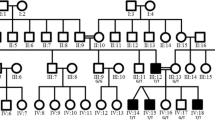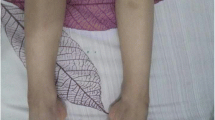Abstract
Charcot-Marie-Tooth disease, type 4D (CMT4D) is a progressive, autosomal recessive form of CMT, characterized by distal muscle weakness and atrophy, foot deformities, severe motor sensory neuropathy, and sensorineural hearing impairment. Mutations in NDRG1 gene cause neuropathy in humans, dogs, and rodents. Here, we describe clinical and genetic features of a 17-year-old male with wasting of hand muscle and foot and severe motor neuropathy. Whole exome sequencing was carried out on the patient and his unaffected parents. We identified a novel deletion of nine nucleotides (c.537 + 2_537 + 10del) on the splice donor site of intron 8 in NDRG1 gene. The Sanger sequencing confirmed the segregation of this mutation in autosomal recessive inheritance. Furthermore, transcript analysis confirmed a splice defect and reveals using of an alternate cryptic splice donor site on the downstream intronic region. It resulted in an insertion of 42 nucleotides to exon 8 of NDRG1. Translation of the resulting transcript sequence revealed an insertion of 14 amino acids in-frame to the existing NDRG1 protein. This insertion is predicted to disrupt an alpha helix which is involved in protein-protein interactions in homologous proteins. Our study expands the clinical and genetic spectrum of CMT4D. The splice defect we found in this patient reveals a novel splice isoform of NDRG1 as the potential cause for the neuropathy observed in this patient.



Similar content being viewed by others
Data availability
The data in this study is available with the corresponding author upon reasonable request. The data is not publicly available due to the patient’s privacy and ethical considerations.
Code availability
Not applicable.
References
Bandari AK et al. (2019) A novel splice site mutation in IFNGR2 in patients with primary immunodeficiency exhibiting susceptibility to mycobacterial diseases Front Immunol 10:1964 doi:https://doi.org/10.3389/fimmu.2019.01964
Bertoni M, Kiefer F, Biasini M, Bordoli L, Schwede T (2017) Modeling protein quaternary structure of homo- and hetero-oligomers beyond binary interactions by homology. Sci Rep 7:10480. https://doi.org/10.1038/s41598-017-09654-8
Biasini M et al (2014) SWISS-MODEL: modelling protein tertiary and quaternary structure using evolutionary information. Nucleic Acids Res 42:W252-258. https://doi.org/10.1093/nar/gku340
Cangul H (2004) Hypoxia upregulates the expression of the NDRG1 gene leading to its overexpression in various human cancers. BMC Genet 5:27. https://doi.org/10.1186/1471-2156-5-27
Chen B, Niu S, Chen N, Pan H, Wang X, Zhang Z (2018) A novel homozygous NDRG1 mutation in a Chinese patient with Charcot-Marie-Tooth disease 4D. J Clin Neurosci 53:231–234. https://doi.org/10.1016/j.jocn.2018.04.024
DePristo MA et al (2011) A framework for variation discovery and genotyping using next-generation DNA sequencing data. Nat Genet 43:491–498. https://doi.org/10.1038/ng.806
Echaniz-Laguna A, Degos B, Bonnet C, Latour P, Hamadouche T, Levy N, Leheup B (2007) NDRG1-linked Charcot-Marie-Tooth disease (CMT4D) with central nervous system involvement. Neuromuscul Disord 17:163–168. https://doi.org/10.1016/j.nmd.2006.10.002
Hunter M et al (2003) Mutation screening of the N-myc downstream-regulated gene 1 (NDRG1) in patients with Charcot-Marie-Tooth Disease. Hum Mutat 22:129–135. https://doi.org/10.1002/humu.10240
Hwang J et al (2011) Crystal structure of the human N-Myc downstream-regulated gene 2 protein provides insight into its role as a tumor suppressor. J Biol Chem 286:12450–12460. https://doi.org/10.1074/jbc.M110.170803
Kachhap SK et al (2007) The N-Myc down regulated Gene1 (NDRG1) Is a Rab4a effector involved in vesicular recycling of E-cadherin. PLoS One 2:e844. https://doi.org/10.1371/journal.pone.0000844
Kalaydjieva L et al (2000) N-myc downstream-regulated gene 1 is mutated in hereditary motor and sensory neuropathy-Lom. Am J Hum Genet 67:47–58. https://doi.org/10.1086/302978
Kalaydjieva L et al (1996) Gene mapping in Gypsies identifies a novel demyelinating neuropathy on chromosome 8q24. Nat Genet 14:214–217. https://doi.org/10.1038/ng1096-214
King RH et al (2011) Ndrg1 in development and maintenance of the myelin sheath. Neurobiol Dis 42:368–380. https://doi.org/10.1016/j.nbd.2011.01.030
Klein CJ (2020) Charcot-Marie-Tooth disease and other hereditary neuropathies. Continuum (Minneap Minn) 26:1224–1256. https://doi.org/10.1212/CON.0000000000000927
Kyuno J, Fukui A, Michiue T, Asashima M (2003) Identification and characterization of Xenopus NDRG1. Biochem Biophys Res Commun 309:52–57. https://doi.org/10.1016/s0006-291x(03)01522-5
Lachat P, Shaw P, Gebhard S, van Belzen N, Chaubert P, Bosman FT (2002) Expression of NDRG1, a differentiation-related gene, in human tissues. Histochem Cell Biol 118:399–408. https://doi.org/10.1007/s00418-002-0460-9
Li H, Durbin R (2009) Fast and accurate short read alignment with Burrows-Wheeler transform. Bioinformatics 25:1754–1760. https://doi.org/10.1093/bioinformatics/btp324
Li LX, Liu GL, Liu ZJ, Lu C, Wu ZY (2017) Identification and functional characterization of two missense mutations in NDRG1 associated with Charcot-Marie-Tooth disease type 4D. Hum Mutat 38:1569–1578. https://doi.org/10.1002/humu.23309
Melotte V, Qu X, Ongenaert M, van Criekinge W, de Bruine AP, Baldwin HS, van Engeland M (2010) The N-myc downstream regulated gene (NDRG) family: diverse functions, multiple applications. FASEB J 24:4153–4166. https://doi.org/10.1096/fj.09-151464
Mustonen V, Muruganandam G, Loris R, Kursula P, Ruskamo S (2021) Crystal and solution structure of NDRG1, a membrane-binding protein linked to myelination and tumour suppression. FEBS J 288:3507–3529. https://doi.org/10.1111/febs.15660
Muthusamy B et al (2020) Exome sequencing reveals a novel splice site variant in HUWE1 gene in patients with suspected Say-Meyer syndrome. Eur J Med Genet 63:103635. https://doi.org/10.1016/j.ejmg.2019.02.007
Muthusamy B et al (2017) Next-generation sequencing reveals novel mutations in X-linked intellectual disability. OMICS 21:295–303. https://doi.org/10.1089/omi.2017.0009
Norton WT, Poduslo SE (1973) Myelination in rat brain: changes in myelin composition during brain maturation. J Neurochem 21:759–773. https://doi.org/10.1111/j.1471-4159.1973.tb07520.x
Okamoto Y et al (2014) Exonic duplication CNV of NDRG1 associated with autosomal-recessive HMSN-Lom/CMT4D. Genet Med 16:386–394. https://doi.org/10.1038/gim.2013.155
Parman Y et al (2004) Clinicopathological and genetic study of early-onset demyelinating neuropathy. Brain 127:2540–2550. https://doi.org/10.1093/brain/awh275
Pietiainen V et al (2013) NDRG1 functions in LDL receptor trafficking by regulating endosomal recycling and degradation. J Cell Sci 126:3961–3971. https://doi.org/10.1242/jcs.128132
Piquemal D, Joulia D, Balaguer P, Basset A, Marti J, Commes T (1999) Differential expression of the RTP/Drg1/Ndr1 gene product in proliferating and growth arrested cells. Biochim Biophys Acta 1450:364–373. https://doi.org/10.1016/s0167-4889(99)00056-7
Piscosquito G et al (2017) A novel NDRG1 mutation in a non-Romani patient with CMT4D/HMSN-Lom. J Peripher Nerv Syst 22:47–50. https://doi.org/10.1111/jns.12201
Skre H (1974) Genetic and clinical aspects of Charcot-Marie-Tooth’s disease. Clin Genet 6:98–118. https://doi.org/10.1111/j.1399-0004.1974.tb00638.x
Taketomi Y et al (2007) Impaired mast cell maturation and degranulation and attenuated allergic responses in Ndrg1-deficient mice. J Immunol 178:7042–7053. https://doi.org/10.4049/jimmunol.178.11.7042
Tazir M, Bellatache M, Nouioua S, Vallat JM (2013) Autosomal recessive Charcot-Marie-Tooth disease: from genes to phenotypes. J Peripher Nerv Syst 18:113–129. https://doi.org/10.1111/jns5.12026
van Belzen N et al (1997) A novel gene which is up-regulated during colon epithelial cell differentiation and down-regulated in colorectal neoplasms. Lab Invest 77:85–92
Vance JM (1991) Hereditary motor and sensory neuropathies. J Med Genet 28:1–5. https://doi.org/10.1136/jmg.28.1.1
Wang K, Li M, Hakonarson H (2010) ANNOVAR: functional annotation of genetic variants from high-throughput sequencing data. Nucleic Acids Res 38:e164. https://doi.org/10.1093/nar/gkq603
Zhou D, Salnikow K, Costa M (1998) Cap43, a novel gene specifically induced by Ni2+ compounds. Cancer Res 58:2182–2189
Acknowledgements
We thank the patient and his parents for providing consent to participate in this study.
Funding
This study was funded by Science and Engineering Research Board (SERB), Department of Science & Technology, Government of India (EMR/2017/004853) to carry out this study and research fellowship for Prashant Phulpagar.
Author information
Authors and Affiliations
Contributions
Babylakshmi Muthusamy and Pramod Kumar Pal conceived and designed the study. Sample collection, processing, data analysis, and interpretation of the results were performed by Babylakshmi Muthusamy. Experiments were performed by Pooja Pravinbabu and Prashant Phulpagar. First draft of manuscript and figure illustrations were prepared by Pooja Pravinbabu and Vikram V Holla. Pramod Kumar Pal, Vikram V Holla, Manjunath Netravati, Ravi Yadav, and Nitish Kamble performed clinical assessment of the patient and provided samples. All authors reviewed the manuscript, provided critical comments to improve the draft, and approved the final version of the manuscript.
Corresponding authors
Ethics declarations
Ethical approval
This study was approved by the ethics committee at the National Institute of Mental Health and Neurosciences (NIMHANS), Bangalore.
Consent to participate
This study was performed after getting appropriate informed consents from the patient and relatives.
Consent for publication
We obtained informed written consent from the patient and his relatives to publish this study.
Conflict of interest
The authors declare no competing interests.
Research involving human participants and/or animals
This study involves human participants. This study was approved by the ethics committee at the National Institute of Mental Health and Neurosciences (NIMHANS), Bangalore.
Additional information
Publisher’s note
Springer Nature remains neutral with regard to jurisdictional claims in published maps and institutional affiliations.
Rights and permissions
About this article
Cite this article
Pravinbabu, P., Holla, V.V., Phulpagar, P. et al. A splice altering variant in NDRG1 gene causes Charcot-Marie-Tooth disease, type 4D. Neurol Sci 43, 4463–4472 (2022). https://doi.org/10.1007/s10072-022-05893-4
Received:
Accepted:
Published:
Issue Date:
DOI: https://doi.org/10.1007/s10072-022-05893-4




